Oxoprobics microplates provide a powerful tool and biological services based on this technology for obtaining proof of mechanism data, useful as first exploratory assessments, refocusing and adapting new tailored methodologies for its use in cell biology (e.g. mitochondrial inhibition or uncoupling, stimulation or inhibition of oxygen-consuming reactions catalyzed by enzymes, antibiotic resistance, etc.) or Immunology (lymphoproliferation kinetics in whole blood, antigen recognition and sensitivity, etc.).
Our proprietary technology could uncover valuable insights to better understand aging (immunosenescence) or cancer (drugs cytotoxicity, inhibitors/promoters linked to cell proliferation or growth inhibition, pro- or anti-angiogenic factors, etc), and even to improve the quality of diagnosis and procedures in other areas… transforming innovative ideas into scientific knowledge!
Oxoprobics sensing plates can be read out by any standard commercially available Time-Resolved Fluorescence (TRF) platform able to accept any standardarized multiwell plates, including 96-well and 384-well formats, or superior:
In this way, readings can be taken several times from each well, using a filter pair, so that the reader captures two signals: firstly an excitation signal at 340 nanometers and emission at 615 nanometers, after a delay of 70 microseconds and a second signal to the same lengths of excitation and emission, but with a delay of 30 microsecond. This makes possible to reduce background noise by delaying the start of the measurement until after the background signal has decayed, enabling much better performance in time-resolved fluorescence assays.
Each well has a biocompatible and biofunctional sensing film which can be read out by any TRF fluorescence reader. Many analytes vary in concentrations in biological systems (e.g. due to aerobic respiration), and some of them can be optically determined, because fluorescence intensity reversibly depends on their occurrence (e.g. oxygen level).
Fluorogenic probes have applicability to a plethora of biosystems, providing high sensitivity, while negligibly perturbing cells and biological systems under investigation.
In abstract, optical sensors and all offered outsourcing services, based on this technology, could be one of the cornerstones to raise our view of cell biology and comprehension of several diseases. We can guarantee consistency and convenience at an affordable price.
A huge number of scientific thought-provoking applications can be devised:
Screening of cell proliferation
Sensing plates can easily follow the cell growth and health by detecting changes of oxygen level
within the biological medium, being able of monitoring cells respiration in real-time or
end-point assays.
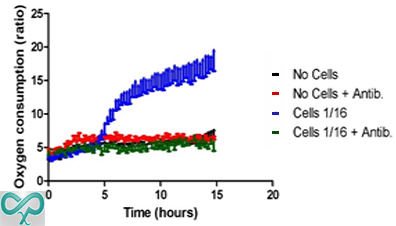 Figure represents E. coli growth al 37ºC (thin-film coating with or witchout antibiotics)
Figure represents E. coli growth al 37ºC (thin-film coating with or witchout antibiotics)
Screening of cytotoxic effects
Despite normal cells meet their energy needs by respiration, hypoxia occurs naturally in
physiological settings, as well as in pathophysiological conditions
Oxoprobics sensing plates can provide an accurate measure of a number of compounds toxicity at
multiple concentrations, by measuring changes in oxygen concentrations, discriminating between
respiration and fermentation pathways
Results are obtained from minutes to days in real time, with only two components: a biological
source and the microplate.
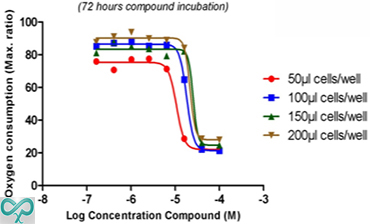 Figure represents different tamoxifen concentrations in lung adanocarinoma H23 cells
Figure represents different tamoxifen concentrations in lung adanocarinoma H23 cells
Profiling of biological fluids
Lymphocytes play important roles in the balance between body defense and noxious 'agents
involved in a number of diseases, including autoimmune diseases, allergic inflammation and
cancer.
Lymphoproliferation measures ability of mitotically inactive lymphocytes (purified preparation
or whole blood) to undergo clonal proliferation when stimulated in vitro by a foreign molecule.
New method of assay have a high performance and potential for real-time HTS screening, resulting
in a powerful compound profiling platform, requiring very simple instrumentation
(non-radioactive) and time-saving processing (PBMCs isolation is not required).
Figures represent data obtained from wholebood or isolated PBMCs distributed into a 384-well Oxoprobics sensing plate.
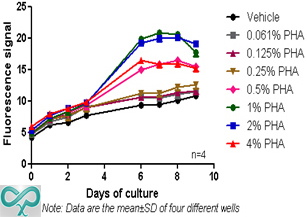
Cell growth measured in whole blood by oxygen consumption (384-well plate)
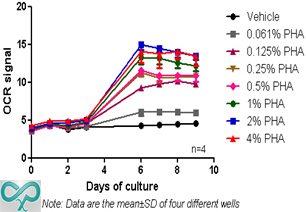
21,250 PBMCs cells/well growth measured by oxygen consumption (384-well plate)
This presentation content and products (as cited above) are intended “for laboratory use only”, as signal detection systems that, by themselves, generate no in vitro diagnostic test results whatsoever, when used in combination with other components and/or equipment dispensed by a qualified end user, however, they could serve as a key component within the final in vitro diagnostic test that the customer could design (both for low complexity tests that can be performed with minimal training, and high complexity tests that require trained lab personnel, involving multiple step protocols and frequent quality control). This information is not an advice, and should not be treated as such.
The content is designed only to provide our customers with information about the
way in which they can easily detect changes in the oxygen concentration, as a means of
determining cellular health parameters, by integrating a standard, simple and miniaturized
measuring device with sensors, made from biocompatible materials.
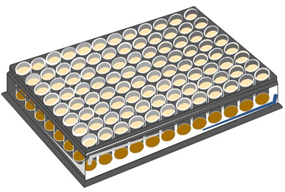
Therefore, Oxoprobics Biosciences and its staff do not provide any form of medical advice, services, nor recommendations, and are not intended and do not constitute unauthorized practice of medicine, nor the provision of health care diagnosis, or treatment. This file is a general summary provided as an information resource only. It should never be used in the case of a medical emergency or for the diagnosis or treatment of any medical condition. Oxoprobics’ microplates are not intended to diagnose, treat, cure, or prevent any disease or medical condition. While we believe you will find the content and products information useful, complete, true, accurate, up-to-date, and non-misleading, we do not guarantee that the content and products will help you achieve specific results in connection with a certain problem.
Highly-credentialed professionals, covering a broad range of disciplines

He is a Ph.D. in Biology from the Univ Autónoma de Madrid (doctoral work at the Puerta de Hierro Hospital, Madrid). After receiving his Ph.D, he moved to the Pathology Department of New York University, as an Assistant Research Professor.
He worked as an Operations Director and Biochemistry Group Leader in diverse Biopharma Companies (Sanofi, LifeLength…).

Ph.D. in Chemistry from Univ. Complutense de Madrid, and he has a postgraduate title in Pharmaceutical Marketing from the Faculty of Economics and Business Administration, UNED.
After a fellowship from Medicinal Chemistry Institute (CSIC), he has more than 20 years’ experience leading Pharma R&D organizations, as an International R&D Core Manager at Sanofi.
Each OCR Kit contains: 2 OCR Plates OCR (ST or LT), Positive Control, Mineral Oil
Development of a new oxygen consumption rate assay in cultures of Acanthamoeba (Protozoa: Lobosea) and its application to evaluate viability and amoebicidal activity in vitro.
Neuroprotective Effect of JZL184 in MPP+-Treated SH-SY5Y Cells Through CB2 Receptors.
Métodos rápidos para la detección de patógenos en la industria biofarmacéutica, cosmética y alimentaria.
Laboratory analysis of soil respiration using oxygen-sensitive microplates.
Development and optimization of new culture media for Acanthamoeba spp.(Protozoa: Amoebozoa)
Readinfo@oxoprobics.com